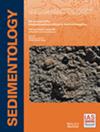高盐度死海的海卤石降水量每小时到每周的变化:蒸发、水冷和淡水羽流稳定性的作用
IF 2.8
2区 地球科学
Q1 GEOLOGY
引用次数: 0
摘要
地质记录中的厚层海绿石序列具有横向变化的特征,反映了环境作用力的时空变化。虽然已经对季节性或更长持续时间内的时间变化进行了研究,但有关数天或数小时的较短持续时间内海绿石沉积动态的信息却十分匮乏。此外,人们对排水量和地表盐度梯度的影响仍然知之甚少。在这里,我们首次在死海海底(水深约 20 米)--唯一的现代深层高盐度水体--实地测量了每小时到每周的哈卤石累积率。开发了新的水下摄影方法,以直接观察湖底的卤石沉淀,同时监测环境驱动因素,即蒸发、气象和湖泊条件。对两种基本环境进行了探索:一种是春季排放产生的稀释羽流环境;另一种是混合高盐环境。重点是冬季的沉积,因为此时的海绿石积累率最高,而且由于水柱垂直均匀,蒸发和海绿石积累之间的关系最为直接。研究发现,两种环境下的卤石累积量存在明显的空间差异,同时每种环境下的卤石累积量也存在小时差异。在混合高盐环境中,在日内时间尺度上,蒸发对海绿石沉淀的影响更大,而温度对季节变化的影响更大。在稀释羽流环境中,浮力羽流的稳定性控制着哈卤石的沉积速率;在暴风期间,羽流受到搅动,表层水盐度较高,哈卤石的积累速率也较高。然而,在风平浪静的情况下,羽流稳定,表层水稀释,哈卤石的堆积速度要低几倍。根据这些新发现,讨论了对解释卤石沉积的影响。本文章由计算机程序翻译,如有差异,请以英文原文为准。
Hourly to weekly variations in halite precipitation from the hypersaline Dead Sea: The role of evaporation, water cooling and freshwater plume stability
Thick‐bedded halite sequences in the geological record are characterized by lateral variations, reflecting spatiotemporal variations in environmental forcing. Although temporal variations have been examined over seasonal scales or longer durations, there is a paucity of information regarding the dynamics of halite deposition at shorter durations of days and hours. Additionally, the influence of water discharges and surface salinity gradients remains poorly understood. Here, for the first time, in situ , hourly to weekly halite accumulation rates were measured on the Dead Sea floor (ca 20 m water depth), the only modern deep and hypersaline water body. Novel underwater photography methods were developed to directly observe halite precipitation at the lake floor, coeval with monitoring of the environmental drives, i.e. evaporation, meteorological and limnological conditions. Two fundamental environments were explored: a diluted plume environment arising from spring discharge; and a mixed hypersaline environment. The focus was on deposition during winter when the halite accumulation rate is highest, and the relationship between evaporation and halite accumulation is most straightforward since the water column is vertically uniform. Significant spatial variations in halite accumulation were found between the two environments, along with hourly variations in each environment. In the mixed hypersaline environment, over intra‐diurnal timescales, evaporation plays a more significant role in halite precipitation, whereas temperature has a greater impact on seasonal changes. In the diluted plume environment, the stability of the buoyant plume controls the rate of halite deposition; during windstorms, the plume is stirred, with higher surface water salinity and higher rate of halite accumulation. However, under calm winds, the plume is stable, with diluted surface water, and the rate of halite accumulation is a few times lower. Following these new findings, the implications for the interpretation of halite deposits are discussed.
求助全文
通过发布文献求助,成功后即可免费获取论文全文。
去求助
来源期刊

Sedimentology
地学-地质学
CiteScore
8.20
自引率
11.40%
发文量
94
审稿时长
6-12 weeks
期刊介绍:
The international leader in its field, Sedimentology publishes ground-breaking research from across the spectrum of sedimentology, sedimentary geology and sedimentary geochemistry.
Areas covered include: experimental and theoretical grain transport; sediment fluxes; modern and ancient sedimentary environments; sequence stratigraphy sediment-organism interaction; palaeosoils; diagenesis; stable isotope geochemistry; environmental sedimentology
 求助内容:
求助内容: 应助结果提醒方式:
应助结果提醒方式:


